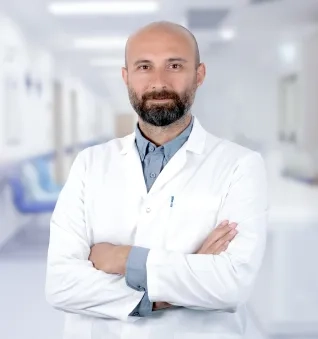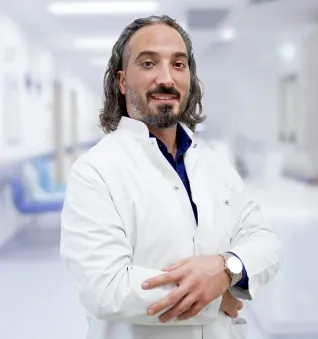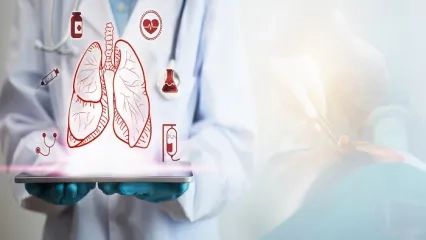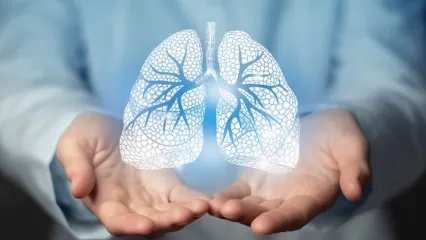Alo Yeditepe
Alo Yeditepe
Lung Cancer
Lung cancer is the most common type of cancer in the world and our country, with the highest death toll. One in five deaths from cancer in both men and women is due to lung cancer. In addition to the increasing incidence due to the increase in cigarette consumption and air pollution, the incidence is constantly increasing among non-smokers due to other factors. Cancer occurs as a result of uncontrolled cell proliferation as a result of DNA damage to the cells in the lung tissue. Uncontrolled proliferation of cells can spread to all organs (metastasis), especially bone and brain, as the disease progresses.
The most important factors in the success of the treatment are the stage of the disease, the cell type, and the general condition of the patient. While complete treatment can be achieved with surgery in the early stages, the chance of success decreases in cases caught in the advanced stage.
Risk Factors and Prevention Methods
Tobacco products are responsible for 90% of lung cancers. Passive cigarette exposure was found as a risk factor in one-third of non-smokers with lung cancer. It has been shown that it increases 23 times in men and 13 times in women who have smoked an average of one pack of cigarettes a day for at least 20 years compared to non-smokers. Although a significant risk increase in the amount of cigarette consumption is determined as an average of 20 years and 1 pack per day, the risk increases in less tobacco use due to starting to smoke at an early age, smoking at home, and occupational and genetic risk factors.
Although the risk of lung cancer begins to decrease from the moment of quitting smoking, significant risk reduction occurs after 25 years. However, this risk is always higher than for individuals who have never smoked.
It is known that the use of cigars increases the risk 3 times, and the use of pipes increases the risk 8 times. However, 'light' cigarettes with low nicotine and tar levels do not reduce the risk either.
- Family history of lung cancer,
- Air pollution,
- Exposure to high-dose radiation,
- Lung damage due to previous diseases,
- Occupational chemical exposure is the other risk factor for lung cancer.
The most important point in the prevention of lung cancer is to avoid smoking. Avoiding inhalation of all toxic agents, especially cigarettes, significantly reduces the risk of disease.
It is also very important to work with protective equipment in compulsory occupational exposures and to minimize the amount of contact with working hours and controls.
Lung Cancer Symptoms and Early Diagnosis Methods
The most common symptoms of lung cancer are cough, bloody sputum, chest pain, hoarseness, unexplained weight loss, shortness of breath, new-onset wheezing, and recurrent pneumonia that is difficult to treat. Apart from these symptoms, patients may also consult a physician with complaints such as unilateral drooping of the eyelid, numbness in the arm, pain, weakness, loss of muscle strength, and head and neck edema. All these signs and symptoms may vary depending on the location and size of the tumor.
Lung cancer often spreads to the bones, brain, and adrenal glands. When it spreads to the bones, it can cause fractures that develop independently of pain and trauma. Epileptic seizures, personality changes, and vision loss can be seen in metastases developing in the brain. Tumors can cause nausea, vomiting, weakness, and clouding of consciousness by disrupting the metabolism of vital minerals such as calcium and sodium, with the spread and the substances they secrete, even outside the place where they are located.
- Cough is the most common complaint among these symptoms. Extreme caution should be exercised when it lasts longer than three weeks or when the existing cough gets worse and increases in frequency. A lesion developing in the trachea may start as a dry cough and turn into a cough with phlegm and bloody cough as it grows. Depending on the obstruction, the secretions in it may develop pneumonia behind the airway that cannot be eliminated and cause wheezing. Most smokers do not care because the cough is seen in most smokers, but the increase in the amount of phlegm within days, fever, bloody sputum, and coarseness in the breathing sounds heard when coughing are very important, especially in smokers. There is no difference in the cough that develops due to the tumor, day and night, or with meals. It also has a very low response to cough suppressants. Approximately one-third of tumors originate from the airway and proliferating cells rich in vascularization are prone to bleeding. Bloody sputum is one of the most important findings for all lung diseases, especially lung cancer.
- Pneumonia develops in the lung areas where the bronchus blocked by the tumor is opened. If pneumonia does not heal or recurs radiologically and clinically, an endoscopic examination of the bronchi, called a bronchoscopy, should be performed. In case of recurrence of bloody sputum and pneumonia in smokers over the age of forty, bronchoscopy should definitely be performed.
- Shortness of breath can be defined as the awareness of the act of breathing that we normally perform without being aware of it. Within the greater airways, wheezing is added to the shortness of breath in the main trachea.
Unless the tumor occupies a very large space in the lung areas where gas exchange is provided, it can occur only with intense exercises, depending on its prevalence and location, or it can occur without exerting any effort. The onset of shortness of breath, especially in smokers, may be an early sign of COPD, a disease as important as lung cancer. - If the tumor is located on the pleura or the chest wall, chest pain that increases with deep breathing can be seen, mostly unilateral and lasting for hours. This type of pain also usually has a weak response to painkillers. Fluid accumulation often occurs in the involvement of the pleura, and the fluid pressing on the lungs can cause shortness of breath, chest pain, and shoulder pain. As the number of fluid increases, it may be accompanied by an increase in the respiratory rate, inability to lie flat, and bruising on the lips.
- A tumor that develops in the upper lobes of the lungs can compress the nerves and cause hoarseness, droopy eyelids, and edema on the face and upper body. Unilateral drooping of the eyelids and the development of a diameter difference in the pupil may be a silent sign of the nerve chains affected by the tumor. A doctor's examination is absolutely recommended for hoarseness that does not have an obvious cause such as infection or reflux and lasts longer than ten days.
As with all types of cancer, early diagnosis of lung cancer saves lives. Screening is recommended with annual chest radiography for smokers, those with a family history of cancer, and those in occupational groups exposed to toxic substances, and with low-dose tomography for high-risk groups over 55 years of age. In these groups, it was determined that chest tomography increases the diagnosis of lung cancer 3 times and the chance of early diagnosis 10 times.
Bronchoscopy examination is recommended for unexplained cough and recurrent pneumonia.
Diagnosis and Staging Methods in Lung Cancer
75-80 percent of diagnosed lung cancer cases are in advanced stages that have lost their chance for surgery. The widespread use of chest tomography in risky groups and its use in the diagnosis of lung cancer have increased the chance of early diagnosis.
If a tumor is suspected in the lung, it is necessary to perform a biopsy of the tissue. If the tumor is close to the airways, a biopsy is taken with bronchoscopy. In tumors that are thought to be inaccessible by bronchoscopy, a sample is taken from the patient's tissue by entering the thorax with biopsy needles from the outside, under the guidance of chest tomography. The definitive diagnosis is made by pathological examination of the removed tissue.
Bronchoscopy is a method of endoscopic examination of the lower respiratory tract and bronchi. The inside of the bronchus and its mucosa are observed with a light camera, and the diameter of the patient tissue, its effects on the trachea, and its vascularization are examined. A biopsy can also be taken from the lymph nodes observed in the tomography.
Another method of diagnosing lung cancer is the examination of cells in phlegm (cytology). Although tumor cells can be observed in the phlegm consisting of lower respiratory tract cells and mucous secretions, the chance of success in this examination is very low.
Lung cancer can be diagnosed with the 'liquid biopsy' method, which has recently been started to be applied in a limited number of centers in our country. Although its use and effectiveness are limited today, its prevalence will increase in the future. Thanks to this method, which makes the diagnosis by separating tumor cells in the blood and performing genetic analysis, it is also possible to follow up on the genetic changes that may develop in the tumor cell during the treatment stages.
Staging is done by identifying tumor size, lymph nodes, and distant organ metastases. PET-CT, which is based on the principle of detecting the uptake of nuclear-labeled glucose in rapidly proliferating cells, and examination of brain tissue with MRI, where the PET-CT method is insufficient, are important methods in staging.
How to Treat Lung Cancer?
The treatments for non-small cell lung cancer and small cell lung cancer are different. Treatment varies according to the stage of the disease.
Depending on the type and stage of lung cancer, some, or all of the options such as surgery, radiotherapy (radiation therapy), chemotherapy (treatment with medications), targeted therapy, and immunotherapy are applied in different sequences according to the characteristics of the patient and the disease.
Cancer treatment aims to eradicate the disease, if possible, to limit it, to prolong survival, and to increase the patient's quality of life. A multidisciplinary approach is very important for the best treatment of lung cancer.
What is a Multidisciplinary Approach and Why is it Necessary?
The situation of each patient with lung cancer is different from each other. The use of different treatment options alone or together according to the disease and the patient's condition requires the joint work of many physicians from different departments and the determination of the most appropriate treatment for the patient with a joint decision.
In this way, the most accurate and up-to-date treatments can be applied without delay. In the multidisciplinary approach, the consensus of medical oncology, thoracic surgery, chest diseases, radiation oncology, pathology, radiology, and nuclear medicine specialists is achieved, and the help of a dietitian, psychiatrist, and pain therapist is requested when necessary.
What is the Role of Surgical Treatment in Lung Cancer?
In the early stages of lung cancer, the most effective treatment is surgery if the patient does not have any other disease that prevents surgery. Patients may refuse treatment when surgery is recommended due to false beliefs such as "Surgery is not appropriate for cancer" and "A biopsy was performed and cancer has spread".
Those who are offered surgical treatment for lung cancer constitute the group of patients whose diseases are at relatively early stages and have the highest chance of long-term disease-free survival when the cancerous tissue can be completely removed by surgery.
In fact, approximately 75-80% of lung cancer patients who apply to the physician have lost the chance of being treated with surgery.
Therefore, surgery cannot be recommended for every patient. If you have been told by your physicians that your disease was detected at an early stage before it spreads far, you need an operation and you are in a position to undergo this surgery due to your general health condition, do not miss this chance. Because it is unlikely that you will have the same chance of recovery with the treatments to be performed instead.
Can the " No Surgery" Decision Be Changed?
Saying "You can't undergo surgery" to a cancer patient is a very important decision for that patient's treatment planning and the chance of recovery.
Therefore, such an important decision should be made meticulously after a detailed examination using high technology. This, inevitably, is directly related to the technological level of the equipment and infrastructure in the institution where the examinations are carried out.
Likewise, physicians who have a share in the diagnosis and staging must have the specialization to best interpret the detailed data obtained in favor of the patient and by reaching a consensus. In Yeditepe University Hospitals, some patients, who were told that they could not have surgery, actually see that they have a chance of surgery as a result of a detailed examination, and these patients can be helped to have a higher chance of survival by performing surgical treatments along with other treatment methods.
What Is Done Before the Decision of Surgery?
If a definitively diagnosed lung cancer patient is found to be at the stage suitable for surgery as a result of staging, the patient should be evaluated in terms of suitability for surgery. In this respect, the patient's age, general condition, other accompanying diseases, especially cardiac and circulatory functions, and lung respiratory capacity are considered.
Advanced age alone does not prevent surgery, and the important thing is the deterioration in heart, lung, brain, and kidney functions that may increase with age. Lung function tests are performed in all patients, and heart functions are evaluated. As a result of this evaluation, the decision of surgery is given to the patients who are found suitable.
What are the Surgical Treatments that Increase the Quality of Life in Lung Cancer Patients?
A significant portion of lung cancer patients is treated with treatment methods other than surgery since their disease has spread to a certain extent. On the other hand, in cases such as fluid or abscess accumulation around the lungs or in the pericardium, air leakage from the lungs, shortness of breath caused by disease-related obstruction and narrowing in the main trachea and bronchial branches, or bleeding from the lungs, which these patients may encounter during their treatment, there are many endoscopic and open surgical interventions that we perform in order to reduce the complaints of our patients and increase their quality of life. Again, since it is known that it is necessary to constantly insert a catheter into the veins of our patients during chemotherapy and this process becomes increasingly difficult due to the narrowing and occlusion of the veins due to medications, PORT catheters, which are hidden under the skin and placed in the main vein, are inserted in our patients in order to continue this treatment easily and without discomfort. With careful and regular use and maintenance, these PORT catheters can be used for years without any problems and provide great comfort to patients.
Chemotherapy is a medication treatment consisting of powerful chemicals used to kill fast-growing abnormal cells in your body. Chemotherapy used in medicine is used to treat many types of cancer because cancer cells grow and multiply much faster than most cells in the body. There are many different chemotherapy drugs used today, and these drugs can be administered to cancer patients alone or in combination. It is important to know that drugs used to treat cancer act differently.
Uses of Chemotherapy in Oncology
- Chemotherapy can be used to completely treat (cure) cancer without other treatments. It can also be used in combination with other treatment methods in certain cases of cancer patients.
- Chemotherapy can be used to kill hidden cancer cells in the body after other treatment methods (surgery) applied to cancer patients. This treatment approach is defined as adjuvant treatment by oncologists.
- Chemotherapy can be used to prepare cancer patients for other treatments (surgery, radiotherapy). The aim here is to make the surgical intervention easier by shrinking the tumor with chemotherapy and to increase the effectiveness of the radiation therapy to be applied. Oncologists define this treatment approach as neoadjuvant treatment.
- It can be used to alleviate the symptoms and complaints of cancer patients. The chemotherapy used for this purpose helps to alleviate cancer symptoms and complaints by killing cancer cells. Oncologists define this treatment approach as palliative chemotherapy.
Side Effects of Chemotherapy
Chemotherapy drugs have side effects and each drug used has different side effects. You can receive information from your doctor about the side effects of chemotherapy drugs used in your treatment, and you can receive preventive or auxiliary drug recommendations to mitigate these effects.
The most common side effects that can be seen during chemotherapy are:
- Nausea
- Vomiting
- Diarrhea
- Hair loss
- Loss of appetite
- Fatigue
- Oral sores
- Pain
- Constipation
- Easy bruising
- Bleeding
Possible Side Effects After Chemotherapy
- Effects on lung and heart functions
- Infertility
- Kidney problems
- Numbness and tingling due to nerve damage (peripheral neuropathy)
Chemotherapy Application Forms
- Intravenous administration
- Oral administration
- Application through the skin
- Direct application into cancer tissue
Immunotherapy in Lung Cancer
Cancer immunotherapy, also known as immuno-oncology, is a form of cancer treatment that uses the strength (cells) of the body's own immune system to prevent, control, and eradicate cancer.
How Do the Effects of Immunotherapy Manifest?
Immunotherapy virtually trains the immune system to recognize and attack certain cancer cells. It increases the number of immune cells, or body defense cells, to help eliminate cancer cells. Additionally, it provides new components to boost the body's immune response.
What are the Advantages of Immunotherapy?
Cancer immunotherapy consists of various components, and these consist of various forms such as targeted antibodies, cancer vaccines, transfer of stimulating cells to the body, tumor-infecting viruses, stopping the checkpoints of defense cells (inhibitors), and thus making them function further. Immunotherapies are a type of biotherapy (also called biological response modifying therapy) because they are also used in the form of using materials from living organisms to fight diseases.
Some immunotherapies are used by genetic engineering to improve the cancer-fighting abilities of immune cells, and these may be referred to as gene therapies. Immunotherapies are used to prevent different types of cancer and manage or treat existing cancer diseases. They can also be used with these treatment methods to increase the effectiveness of surgery, chemotherapy, radiotherapy, or targeted therapies applied in the treatment of cancer patients.
Advantages of Immunotherapies
The immune system is sensitive, so it is possible to target only cancer cells while protecting healthy cells. Just like cancer, the immune system of living beings can adapt to environmental conditions continuously and dynamically and gain new features. For this reason, even if it manages to evade the detection of defense cells, which is one of the most important features of cancer, the immune system can re-evaluate this situation and initiate a new attack on cancer cells with this new feature. Also, immunotherapies allow the immune system to remember what cancer cells look like (memory cells) so that if cancer cells regenerate, the defense cells can again target and eliminate cancer that has formed without needing any help.
Impact Areas and Side Effects of Immunotherapies
Immunotherapy can be used in diseases such as lung cancer, urinary bladder, lymphoma, colon and rectum, esophagus, head and neck, liver, uterus, melanoma, Merkel cell carcinoma, and squamous cell carcinoma of the skin. In addition, regardless of the organ where the cancer is located, it can be used without the need for any other data if there is a condition such as genetic damage (MSI-H) or the tumor mutation load is high (TMB-H). However, one of the most important concepts to know is that immunotherapy may not always work for every patient.
Certain types of immunotherapies have potentially serious but manageable side effects. The side effects of immunotherapy can often result from stimulation of the immune system, ranging from minor inflammatory reactions and flu-like complaints to major disorders such as self-harm of the body (autoimmune), and potentially life-threatening conditions. Common side effects of immunotherapies include skin reactions (redness, itching), mouth sores, fatigue, nausea, body aches, headaches, and changes in blood pressure.
Lung Cancer and Radiotherapy
Radiotherapy, also known as radiation therapy, is a treatment method that aims to eradicate tumor cells with high-energy rays, especially X-rays. It is applied in varying doses and frequencies according to the patients. In the irradiation performed by targeting the tumor, the healthy tissue around the tumor may also be damaged.
Side effects related to radiotherapy mostly develop due to the damage to these healthy tissues and start in the second week after the start of the treatment and continue for 2-3 weeks after the end of the treatment. Although it is not common, it can also cause permanent damage.
When the intact lung tissue around the irradiated tumor is affected, dry cough, fever, and shortness of breath may begin. When these symptoms develop, they should be shared with the relevant doctor. There may be itching and redness on the skin included in the treatment area, and cosmetic products should not be used in the areas included in the irradiation area in order not to increase the damage. Another organ in the chest that will be affected by radiotherapy is the esophagus. Difficulty in swallowing and painful swallowing may develop. Acidic and bitter foods should be avoided during these periods in order not to increase damage to the esophagus. Alcohol and cigarette use should be avoided during the treatment.
Nutrition and Lifestyle Recommendations for Patients with Lung Cancer
In patients with lung cancer, the basal caloric requirement of the body increases due to the increased metabolic activity of the tumor. An increased caloric requirement cannot be met in patients who develop loss of appetite due to chemotherapy and radiotherapy, and rapid weight and muscle loss is observed in patients. The general condition of the patient is very important for treatment success and survival. Determining the total caloric requirement and deficiency of the patients, and supplementing the missing calories, vitamins and minerals increase the patient's quality of life and treatment success and reduce the side effects of chemotherapy.
Nutritional solutions and high protein supplements should be given to patients who receive less than half of the calories they need for more than 10 days, or who are known to be unable to eat for more than a week. In patients with weakened immunity and increased susceptibility to infections during chemotherapy, it is recommended not to consume raw vegetables and fruits without making sure that they are cleaned very well, and to stay away from crowded and closed environments to protect against all infectious diseases during these processes.
Alternative treatment methods such as phytotherapy/herbal product supplementation, which are increasingly used today and are frequently recommended to cancer patients, should not be used without consulting a physician because of the possibility of decreasing the effectiveness of chemotherapy and increasing its toxicity.
During the treatment of lung cancer, general health, and hygiene precautions should be followed carefully, and complaints such as fever, weight loss, yellowing, nausea, and vomiting should be reported to the physician following up with the patient.
This content was prepared by Yeditepe University Hospitals Medical Editorial Board.
”
See Also
- How to Cleanse Your Lungs?
- Is Breathing Air Dangerous in Fires?
- How Should Patients Receiving Chemotherapy Eat?
- What is Chemotherapy? How is it Applied?
- His Trachea was 95 Percent Closed, He Returned to Life with 10 Hours of Surgery
- What is Electronic Cigarette Disease (EVALI)? EVALI Symptoms and Treatment
- What is COPD? Symptoms and Treatment of COPD
- Long Journeys Increase the Risk of Embolism!
- What Asthma and COPD Patients Should Pay Attention to When Using Air Conditioning!
- What is Allergy? What are the Symptoms of Allergy?
- What is Desert Dust? Harms of Desert Dust
- Is Cancer a Treatable Disease?
- What is Tuberculosis (TB)? Symptoms and Treatment
- Nutrition in Cancer
- Cancer Treatment Methods
- Circadian Rhythm Disorder
- Lung Cancer Screening Age
- What is Good for Cough? How to Cure Cough?
- Lung Cancer Symptoms and Treatment
- 10 Ways to Have a Sound Sleep in the Heat
- He Couldn't Breathe; He Regained His Health with the Application of 3 Different Special Surgical Techniques Together
- What Should Asthma Patients Be Cautious About?
- Does Poor Quality Sleep Increase The Risk of Asthma?
- Voice Can be Lost If Tracheal Stenosis is Not Detected Early
- What is Allergy? What are Allergy Symptoms?
- What Causes Insomnia, Diagnosis and Treatment
- Unable to Speak Due to Her Illness, Sibel: I Could Not Tell My Children 'I am Here' During the Earthquake
- 9 Common Misconceptions About COPD
- Causes, Symptoms, and Treatment of Asthma
- Treatments that Reduce Life Loss in Cancer Give Hope!
- COPD Makes You Age Early
- Treated For Asthma For Two Years But Has Had A Tumour In Her Trachea
- Allergy and Asthma During Pregnancy
- It Is Aimed to Eliminate Tuberculosis Worldwide By 2030
- Chance of Treatment in Patients Who Have a Tube Inserted in Their Throat to Breathe
- Pollen is Now Seen Outside of Seasonal Changes
- Do Dental Caries Increase the Risk of Pneumonia?
- Lung Patients Should Not Stop Their Medications
- Young Man Who Lost His Voice Due to Tracheostomy Regained His Voice After Months
- Smoking Rates Under the Age of 15 Are Increasing
- Inhaling Electronic Cigarettes for a Few Minutes Causes Damage to Vein Wall
- 4 Significant Preliminary Symptoms of Lung Cancer
- People Who Smoke More Than 25 Cigarettes a Day Have a 50-fold Increased Risk of Lung Cancer
- How Does Acid Rain Affect Human Health?
- Do Individualized Treatments Offer Hope for Cancer?
- Can Back Pain Be A Sign of Lung Cancer?
- The Cause of Shortness of Breath May be Trachea Stenosis
- Nine Out of Ten COPD Patients Do Not Know They Are Sick
- It Is Possible to Prevent Possible Complications of Intubation
- The Slowing Traffic in Istanbul Increases the Risk of Cancer!
- The Tumor in the Trachea was Removed Without Damaging the Vocal Cords
- The American Cancer Society Has Announced; The Age of Screening For Lung Cancer Has Decreased
- Survived Coronavirus, Had Windpipe Blockage Months Later, Returned From Death
- Hidden Lung Cancer Cases Revealed in Tomographs Taken Due to Coronavirus
- The Hope of ‘Immunotherapy’ in Advanced-Stage Cancer Treatment
- Quitting Smoking Even After Diagnosing Lung Cancer Effects Lifespan
- Electronic Cigarettes Can Cause Heart Attacks!
- Cancer Statistics Reveal the Importance of Protecting Against Cancer
- New Research Points to the Important Issues in Breast Cancer
- Found Out That She Had Cancer After Her Accident, and Immunotherapy Was Her Solution!
- Pollen Allergy Has No Season
- Beware of Little-Known Risks of Smoking!
- Obesity is Both a Cause and Consequence of Sleep Apnea
- The Young Man Whose Trachea Was Completely Blocked After An Accident Regained Both His Health and His Voice
- Life Support Booklet for Oncology Patients
- Asthma and COPD Attack Season Begins
- What is Intubation?
- False Facts in Cancer
- Most Common Cancers
- Snoring and Its Treatment
- Common Misconceptions About Cancer
- Does the Pneumonia Vaccine Protect Against the Coronavirus?
- New Treatment Approaches Promising in Metastatic Breast Cancer
- In Case You Are Unable To Sleep Even If You Are Tired, Your Circadian Rhythm May Be Disrupted
- Using Antipyretics Uncontrolled Can Hide Pneumonia Symptoms
Alo Yeditepe










